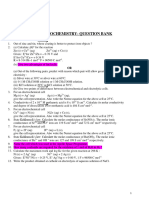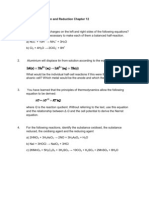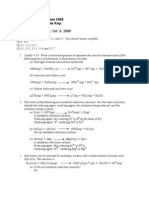Ejercicios Química
Ejercicios Química
Uploaded by
AndreaForteRuizCopyright:
Available Formats
Ejercicios Química
Ejercicios Química
Uploaded by
AndreaForteRuizOriginal Description:
Original Title
Copyright
Available Formats
Share this document
Did you find this document useful?
Is this content inappropriate?
Copyright:
Available Formats
Ejercicios Química
Ejercicios Química
Uploaded by
AndreaForteRuizCopyright:
Available Formats
Department of Engineering Area of Chemical Engineering
Agricultural Engineering
Year 1
Module: Chemistry 2
TOPIC 3 EXERCISES
1.- The following redox reaction is used in acidic solution in the Breathalyzer test to determine the
level of alcohol in the blood:
H + (ac ) + Cr2 O 72 (ac ) + C 2 H 5 OH (ac ) Cr 3+ (ac ) + C 2 H 4 O (ac ) + H 2 O (l )
(a) Identify the elements undergoing changes in oxidation state and indicate the initial and final
oxidation numbers for these elements; (b) write and balance the reduction half-reaction; (c) write
and balance the oxidation half-reaction; (d) combine the half-reactions to produce a balanced redox
equation.
2.- A basic solution of hypochlorite ions reacts with solid chromium (III) hydroxide to produce
aqueous chromate ions and chloride ions. Write the net ionic equation for the reaction.
3.- Balance each of the following skeletal equations by using oxidation and reduction half-reactions.
Identify the oxidizing agent and reducing agent in each reaction.
(a) Reaction of thiosulphate ion with chlorine gas, in acidic aqueous solution:
Cl 2 (g ) + S 2 O 32 (ac ) Cl (ac ) + SO 24- (ac )
(b) Reaction of elemental phosphorus to form phosphine (PH3), a poisonous gas with the odour of
decaying fish, in basic aqueous solution:
P4 (s ) H 2 PO 2 (ac ) + PH 3 (g )
4.- (a) Write the half-reactions and the balanced equation for the cell reaction for each of the
following galvanic cells. Draw a schematic representation of each cell.
(1)
Ni (s ) Ni 2 + (ac ) Ag + (ac ) Ag (s )
(2)
Pt (s ) O 2 (g ) H + (ac ) OH (ac ) O 2 (g ) Pt (s )
(b) Write the half-reactions and the balanced equation for the cell reaction, and the cell diagram for
each of the following skeletal equations. Draw a schematic representation of each cell.
(1) Mn (s ) + Ti 2+ (ac ) Mn 2+ (ac ) + Ti (s )
(2)
Cu + (ac ) Cu 2 + (ac ) + Cu (s )
5.- A student was given a standard Cu(s)Cu2+(aq) half-cell and another half-cell containing an
unknown metal M immersed in 1 M M(NO3)2(aq). When the copper was connected as the anode at
25 C, the cell potential was found to be -0.689 V. What is the reduction potential for the unknown
M2+/M couple? E(Cu2+/Cu) = +0.34 V.
Answer: -0.349 V
6.- Suppose that each of the following pairs of redox couples is joined to form a galvanic cell that
generates an electric current under standard conditions. Identify the oxidizing agent and the
1
Area of Chemical Engineering
Chemistry 2
reducing agent, write a cell diagram, and calculate the standard cell potential. (a) Co2+/Co and
Ti3+/Ti2+; (b) H+/H2 and Fe3+/Fe2+. E(Co2+/Co) = -0.28 V; E(Ti3+/Ti2+) = -0.37 V; E(H+/H2) = 0 V;
E(Fe3+/Fe2+) = +0.77 V.
Answer: +0.09 V; +0.77 V
7.- Determine the equilibrium constants for the following reactions. E(Ti2+/Ti) = -1.63 V;
E(Mn2+/Mn) = +1.18 V; E(In3+/In2+) = -0.49 V; E(U4+/U3+) = -0.61 V.
2+
2+
(a) Mn (s) + Ti (aq) Mn (aq) + Ti (s)
(b)
+
+
2+
4+
In 3(aq)
+ U 3(aq)
In (aq)
+ U (aq)
Answer: 6.1210-16;1.07 102
8.- Calculate the reaction quotient, Q, for the cell reaction, given the measured values of the cell
potential. Balance the chemical equations by using the smallest whole-number coefficients.
E(Pb4+/Pb2+) = +1.67 V; E(Sn4+/Sn2+) = +0.15 V; E(Cr2O72-,H+/Cr3+) = +1.33 V; E(O2,H+/H2O) =
+1.23 V.
4+
2+
4+
2+
E = +1.33V
(a) Pt (s ) Sn (aq) , Sn (aq) Pb (aq) , Pb (aq) C (gr ) ,
(b)
+
+
3+
Pt (s ) O 2 (g ) H (aq)
Cr2 O 72 (aq) , H (aq)
, Cr(aq)
Pt (s) ,
E = +0.1V
Answer: 2.64106; 1
9.- Make a schematic drawing and determine the potential of each of the following cells. Calculate
the reaction quotient, Q, for the cell reaction. Balance the chemical equations by using the smallest
whole-number coefficients. E(H+/H2) = 0 V; E(Ni2+/Ni) = -0.23 V; E(Zn2+/Zn) = -0.76 V.
(a)
Pt (s ) H 2 (g, 1.0 bar ) HCl (aq, 0.075 M ) HCl (aq, 1.0 M ) H 2 (g, 1.0 bar ) Pt (s )
(b)
Zn (s ) Zn 2+ (aq, 0.37 M ) Ni 2+ (aq, 0.059 M ) Ni (s )
Answer: +0.066 V, 5.62510-3; +0.506 V, 6.271
10.- (a) Calculate the voltage of an electrochemical cell that consists of pure lead immersed in a
510-2 M Pb2+ ion solution and pure tin immersed in a 0.25 M Sn2+ ion solution at 25 C. (b) Write
the equation of the spontaneous electrochemical reaction. E(Sn2+/Sn) = -0.136 V; E(Pb2+/Pb) = 0.126 V.
Answer: -0.011 V; +0.011 V
11.- An electrochemical cell is constituted by pure copper and cadmium electrodes immersed in
aqueous solutions of their respective ions, Cu2+ and Cd2+. When the concentration of Cd2+ is
6.510-2 M, the electrode of cadmium is oxidized and produces a potential of 0.775 V. Calculate the
concentration of Cu2+ ion if the temperature is 25 C. E(Cd2+/Cd) = -0.403 V; E(Cu2+/Cu) = +0.34
V.
Answer: 0.785 M
12.- A tin electrode in 0.015 M Sn(NO3)2(aq) is connected to a hydrogen electrode in which the
pressure is 1 bar. If the cell potential is 0.061 V at 25 C, what is the pH of the electrolyte at the
hydrogen electrode? Make a schematic drawing of the cell.
Answer: 2.25
13.- Consider the cell Ag(s)Ag+(aq,5mM)Ag+(aq,0.15M) Ag(s). Can this cell do work? If so, what is
the maximum work that it can perform (per mole of Ag)?
Answer: yes, 8.43 kJ
2
Area of Chemical Engineering
Chemistry 2
14.- Predict the products resulting from the electrolysis of 1 M AgNO3(aq).
Answer: cathode, Ag; anode, O2
15.- A 1 M NiSO4(aq) solution was electrolyzed by using inert electrodes. Make a schematic drawing
of the cell. Write: (a) the cathode reaction; (b) the anode reaction; (c) with no overpotential or
passivity at the electrodes, what is the minimum potential that must be supplied to the cell for the
onset of electrolysis?
Answer: +1.46 V
16.- Aqueous solutions of (a) Mn2+; (b) Al3+; (c) Ni2+; (d) Au3+ with concentrations of 1 mol L-1 are
electrolyzed at pH = 7. Determine whether the metal ion or water will be reduced at the cathode.
E(H2O/H2,OH-)(pH = 7) = -0.42 V; E(Mn2+/Mn) = -1.18 V; E(Al3+/Al) = -1.66 V; E(Ni2+/Ni) = 0.23 V; E(Au3+/Au) = +1.40 V.
Answer: water; water; Ni2+; Au3+
17.- What amount (in moles) of Al(s) can be produced from Al2O3 if 5 mol e- is supplied?
Answer: 1.7 mol Al
18.- Determine the mass (in grams) of magnesium metal that can be obtained from molten
magnesium chloride, by using a current of 7.3 A for 2.11 h. What volume of chlorine gas at 25 C
and 1 atm will be produced at the anode? M(Mg) = 24 g mol-1; F = 9.65104 C (mol e-)-1.
Answer: 6.89 g; 7.02 L
19.- A total charge of 4.5 kC is passed through an electrolytic cell. Determine the quantity of
substance produced and make a schematic drawing of the cell in each case: (a) the mass (in grams)
of bismuth metal from a bismuth nitrate solution; (b) the volume (in litres at 273 K and 1 atm) of
hydrogen gas from a sulphuric acid solution: (c) the mass of cobalt (in grams) from a cobalt (III)
chloride solution. M(Bi) = 208.98 g mol-1; M(Co) = 58.93 g mol-1; F = 9.65104 C (mol e-)-1.
Answer: 3.25 g; 0.522 L; 0.92 g
20.- Determine the time, in hours, required to electroplate 7 g of magnesium metal from molten
magnesium chloride, by using a current of 7.3 A. M(Mg) = 24 g mol-1; F = 9.65104 C (mol e-)-1.
Answer: 2.14 h
21.- (a) How much time is required to electroplate 1.5 g of silver from a silver nitrate solution by
using a current of 13.6 mA? (b) When the same current is used for the same length of time, what
mass of copper can be electroplated from a copper (II) sulphate solution? M(Ag) = 107.87 g mol-1;
M(Cu) = 63.55 g mol-1; F = 9.65104 C (mol e-)-1.
Answer: 27.4 h; 0.44 g
22.- (a) Suggest two metals that could be used for cathodic protection of a titanium pipeline; (b)
What factors other than relative positions in the electrochemical series need to be considered in
practice? (c) Often copper pipeline is connected to iron pipes in household plumbing systems. What
is a possible effect of the copper on the iron pipes?
You might also like
- Aquarium Log - v2.0Document21 pagesAquarium Log - v2.0ompol dewoNo ratings yet
- 3406 CAT Wear LimitDocument16 pages3406 CAT Wear LimitDany LeaNo ratings yet
- Electrochemistry (2010-2024)Document5 pagesElectrochemistry (2010-2024)soofia baufelNo ratings yet
- Electrochemistry Board Questions 2010Document4 pagesElectrochemistry Board Questions 2010amone nNo ratings yet
- Tutorial 3 ElectrochemistryDocument6 pagesTutorial 3 ElectrochemistrymunirahNo ratings yet
- C 2 Amal 1 Galvanic 2017Document16 pagesC 2 Amal 1 Galvanic 2017kjjkimkmkNo ratings yet
- Tutorial 4 - ElectrochemistryDocument3 pagesTutorial 4 - ElectrochemistryAnis IssabellaNo ratings yet
- Electro - Thermo-Chemistry Tutorial SheetDocument3 pagesElectro - Thermo-Chemistry Tutorial SheetluganomwanakulaNo ratings yet
- CHM271 - Tutorial 4 - ElectrochemistryDocument5 pagesCHM271 - Tutorial 4 - Electrochemistrynurfarisha2809No ratings yet
- Test (Electrochemistry) For PracticeDocument2 pagesTest (Electrochemistry) For PracticebhaimaipdhrhahuNo ratings yet
- Electrochemistry 1Document8 pagesElectrochemistry 1radhikase32No ratings yet
- Chemistry Electrochemistry Practice QuestionsDocument2 pagesChemistry Electrochemistry Practice QuestionsVanessa AlexanderNo ratings yet
- ElectrochemistryDocument106 pagesElectrochemistrySeng IvanNo ratings yet
- Electrochemistry SumsDocument9 pagesElectrochemistry Sumssankarie.1980No ratings yet
- Redox Review - IB-Short QuestionsDocument8 pagesRedox Review - IB-Short QuestionsStephanie LeeNo ratings yet
- Assignment 4 StudDocument4 pagesAssignment 4 StudutpNo ratings yet
- Assignment 1Document2 pagesAssignment 1Oola Simon PeterNo ratings yet
- Reduction-Oxidation Reactions and ElectrochemistryDocument14 pagesReduction-Oxidation Reactions and Electrochemistrykaushi123No ratings yet
- Revision Worksheet 1 On Chapter ElectrochemistryDocument3 pagesRevision Worksheet 1 On Chapter Electrochemistrywww.luciannarikaNo ratings yet
- Revision Worksheet 1 On Chapter ElectrochemistryDocument3 pagesRevision Worksheet 1 On Chapter Electrochemistrywww.luciannarikaNo ratings yet
- Electrochemistry Past Papers 2022-14Document4 pagesElectrochemistry Past Papers 2022-14Venugopal JujhavarappuNo ratings yet
- Electrochemistry Past Papers 2022-14Document4 pagesElectrochemistry Past Papers 2022-1410 A Pratyush Dubey50% (2)
- MCQ - Test 3 With - KeyDocument6 pagesMCQ - Test 3 With - KeyShubham Baxla (CSEAIML23310662409:30)No ratings yet
- CH 11 Practice ProblemsDocument16 pagesCH 11 Practice ProblemsAnivia12100% (1)
- Tutorial (Electrochemistry)Document4 pagesTutorial (Electrochemistry)Amir Aiman AniqNo ratings yet
- Electrochemistry AssignmentDocument3 pagesElectrochemistry AssignmentSulekha SharmaNo ratings yet
- Chapter 3 ElectrochemistryDocument8 pagesChapter 3 Electrochemistrymeshal retteryNo ratings yet
- Problem Set On ElectrochemistryDocument2 pagesProblem Set On ElectrochemistryMark Cliffton BadlonNo ratings yet
- RedoEqui 3 2 12Document3 pagesRedoEqui 3 2 12Huzeyfa Hassan LatheefNo ratings yet
- Electrochemistry ProblemsDocument14 pagesElectrochemistry ProblemsExporting WarriorNo ratings yet
- Electrochemistry 1Document6 pagesElectrochemistry 1waseelahajoke2007No ratings yet
- Electrochemistry QuestionsDocument4 pagesElectrochemistry Questionsbonahailu2580No ratings yet
- Echem WKST KeyDocument7 pagesEchem WKST KeyNurul Hana OmarNo ratings yet
- Assignment 2Document1 pageAssignment 2Oola Simon PeterNo ratings yet
- Practice Sheet - ElectrochemistryDocument2 pagesPractice Sheet - ElectrochemistrydravyagangwalNo ratings yet
- LT Iit Che DPT - 15 - 21.02.2024Document3 pagesLT Iit Che DPT - 15 - 21.02.2024Deena chemistNo ratings yet
- Worksheet Chemo G 12 Unit Tu 22 2016Document9 pagesWorksheet Chemo G 12 Unit Tu 22 2016Dagim YenenehNo ratings yet
- Soal ElectrochemistryDocument3 pagesSoal ElectrochemistryHerlinda OktaNo ratings yet
- 1370 - 262 - Textbooksolution - PDF 2Document19 pages1370 - 262 - Textbooksolution - PDF 2PushkarsinghNo ratings yet
- Module 7 Problem Set Answer KeyDocument3 pagesModule 7 Problem Set Answer KeyPauline Grace CadusaleNo ratings yet
- ELECTROCHEMISTRY Worksheet With AnswersDocument5 pagesELECTROCHEMISTRY Worksheet With AnswersG.D. Pranav.LaskhminarasimhanNo ratings yet
- SCH4U SummativeDocument4 pagesSCH4U Summativekomal sheikhNo ratings yet
- C3 TutoDocument2 pagesC3 TutoaliesyaNo ratings yet
- Electro ChemDocument27 pagesElectro ChemTori RodriquezNo ratings yet
- Electrochem AP HW ProblemsDocument3 pagesElectrochem AP HW ProblemsBrandon DuanNo ratings yet
- Electrochemistry Worksheet 2: Done in FigDocument8 pagesElectrochemistry Worksheet 2: Done in Figrezwanur rahmanNo ratings yet
- Chapter 3 - ElectrochemistryDocument17 pagesChapter 3 - ElectrochemistryMahendhiran MariappanNo ratings yet
- CHEM1070A: Principles of Modern Chemistry: Tutorial 9 ElectochemsitryDocument7 pagesCHEM1070A: Principles of Modern Chemistry: Tutorial 9 ElectochemsitrymirandatwongNo ratings yet
- Electrochemistry 12THDocument12 pagesElectrochemistry 12THaayanNo ratings yet
- CH 17Document15 pagesCH 17sujalgupts526No ratings yet
- Electrochemistry MCQ SendDocument7 pagesElectrochemistry MCQ SendRajendra ChikkamathNo ratings yet
- ElectrochemistryDocument6 pagesElectrochemistrytwinkleparmar0064No ratings yet
- CHE1010 Tutorial Sheet 5Document4 pagesCHE1010 Tutorial Sheet 5Chimuka Onson MapikiNo ratings yet
- Electrochemistry: E° (Cathode) - E° (Anode) G - nFE F 96,485J/ V X Mols G GDocument15 pagesElectrochemistry: E° (Cathode) - E° (Anode) G - nFE F 96,485J/ V X Mols G GandrewNo ratings yet
- CHAPTER 9 Electrochemistry Structure and Essay 13-19Document5 pagesCHAPTER 9 Electrochemistry Structure and Essay 13-19peter edwardNo ratings yet
- 12TH Grade Electrochemistry Worksheet-1Document3 pages12TH Grade Electrochemistry Worksheet-1Amen RaipurNo ratings yet
- ANSWERS at Re Electro Nuclear FuelDocument9 pagesANSWERS at Re Electro Nuclear Fueljudah pabicoNo ratings yet
- Electrochemistry Class 12 NotesDocument53 pagesElectrochemistry Class 12 NotesGirish Arora0% (1)
- Solutions To Problem Set 2Document5 pagesSolutions To Problem Set 2Andy Nguyen100% (1)
- Electro Chemistry Assignment For Iitjee PDFDocument19 pagesElectro Chemistry Assignment For Iitjee PDFggk20130% (2)
- Practice Makes Perfect in Chemistry: Oxidation-ReductionFrom EverandPractice Makes Perfect in Chemistry: Oxidation-ReductionRating: 5 out of 5 stars5/5 (1)
- Practice Makes Perfect in Chemistry: Oxidation-Reduction with AnswersFrom EverandPractice Makes Perfect in Chemistry: Oxidation-Reduction with AnswersNo ratings yet
- T4-Bab 5 SoalanDocument4 pagesT4-Bab 5 Soalanhanida afdhalNo ratings yet
- Shobhit ScienceDocument126 pagesShobhit ScienceMack Tripathi100% (1)
- S.3 Chemistry MR SsemugoomaDocument9 pagesS.3 Chemistry MR SsemugoomalionlioneenjohnsmithNo ratings yet
- MOC DetailsDocument2 pagesMOC DetailsrammaheNo ratings yet
- Cyanex 272Document37 pagesCyanex 272partyweirdo100% (2)
- The Periodic Table of ElementsDocument4 pagesThe Periodic Table of ElementsFatema KhatunNo ratings yet
- Reference Material Certificate: Aluminium Base (Type of Standard) Alsi, Set 420Document2 pagesReference Material Certificate: Aluminium Base (Type of Standard) Alsi, Set 420Hanna Abou El SaadNo ratings yet
- Chromite Mineral FactsDocument3 pagesChromite Mineral FactsJunel AlapaNo ratings yet
- IGCSE Chem LoresDocument16 pagesIGCSE Chem LoresApples ATGSNo ratings yet
- Unsur Golongan TransisiDocument18 pagesUnsur Golongan TransisiRomzi Al Amiri ZainNo ratings yet
- 0620 Chemistry: MARK SCHEME For The May/June 2010 Question Paper For The Guidance of TeachersDocument6 pages0620 Chemistry: MARK SCHEME For The May/June 2010 Question Paper For The Guidance of TeachersHaris AwanNo ratings yet
- 2012 BookMatter EnergyDocument88 pages2012 BookMatter EnergyLutfi ZakariaNo ratings yet
- D and F BlockDocument40 pagesD and F BlockSAI SUDARSHANNo ratings yet
- Periodic Table Inquiry Lab PDFDocument4 pagesPeriodic Table Inquiry Lab PDFjobspackagingNo ratings yet
- ILC Plan - STH 19 FINLDocument7 pagesILC Plan - STH 19 FINLShreya Test HouseNo ratings yet
- Cambridge IGCSE: Co-Ordinated Sciences 0654/22Document20 pagesCambridge IGCSE: Co-Ordinated Sciences 0654/22Hen RyNo ratings yet
- EsparragosDocument134 pagesEsparragosNelloNo ratings yet
- WRL Corporate Presentation WebsiteDocument108 pagesWRL Corporate Presentation WebsiteGirish PillayNo ratings yet
- Chemical Reactions Booklet - Shobhit NirwanDocument21 pagesChemical Reactions Booklet - Shobhit NirwanOWAIS AHMED87% (15)
- Hasil LAB BBM Jan 2019 PDFDocument3 pagesHasil LAB BBM Jan 2019 PDFpaulNo ratings yet
- Basic Atomic Structure WorksheetDocument4 pagesBasic Atomic Structure WorksheetTrisha GolesNo ratings yet
- Stoichiometry Notes KEYDocument17 pagesStoichiometry Notes KEYOnofre Algara Jr.No ratings yet
- Types of Chemical Reactions - Introduction and ExamplesDocument5 pagesTypes of Chemical Reactions - Introduction and ExamplesK.S.Yogeswar 7-CNo ratings yet
- OREAS 203 DatapackDocument58 pagesOREAS 203 DatapackWidy macNo ratings yet
- Ionpac Cs5A Column & Metpac Reagents: Rapid, Routine Analysis of Transition Metals in Diverse SamplesDocument6 pagesIonpac Cs5A Column & Metpac Reagents: Rapid, Routine Analysis of Transition Metals in Diverse Samplescecilia elizabeth quiroga talledoNo ratings yet
- A New Multifunctional Corrosion and Scale Inhibitor - 2008Document13 pagesA New Multifunctional Corrosion and Scale Inhibitor - 2008Benoit EmoNo ratings yet
- June 2022 (v1) QP - Paper 4 CAIE Chemistry IGCSEDocument16 pagesJune 2022 (v1) QP - Paper 4 CAIE Chemistry IGCSERimNo ratings yet
- Determination of %age Purity NaClDocument6 pagesDetermination of %age Purity NaClRana NaveedNo ratings yet

























































































